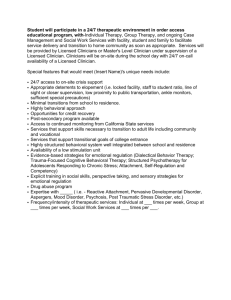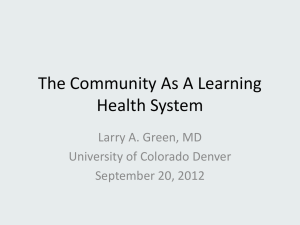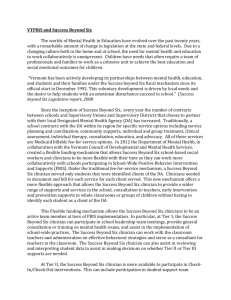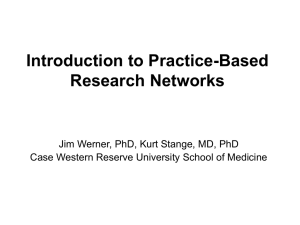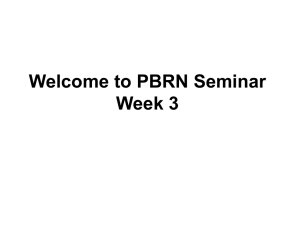Data Collection Methods
advertisement
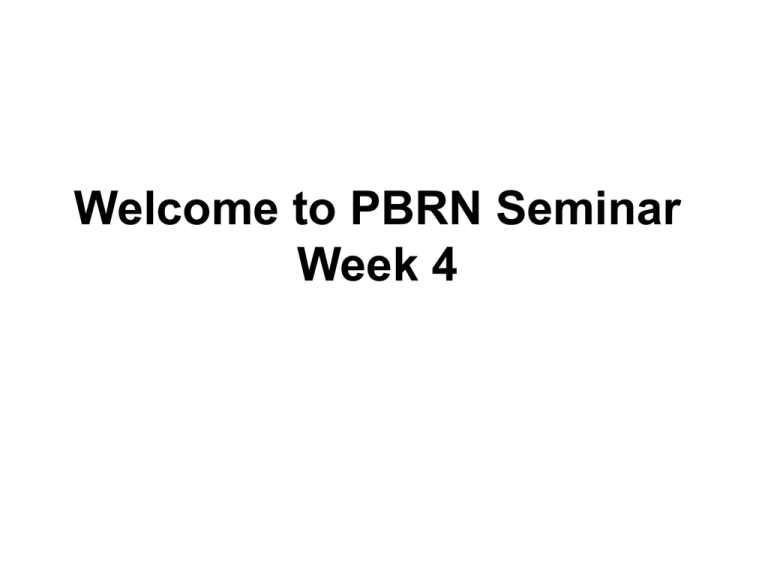
Welcome to PBRN Seminar Week 4 To this point… Weeks 1 & 2: What are PBRNs? What do PBRNs do? Why are PBRNs important? What are the key components of PBRNs? How do PBRNs function? Last week: What are the steps in developing a PBRN? How generalizable are PBRN research findings to non-PBRN practices? Tonight • Louise Acheson, MD, MS – Professor, Case Department of Family Medicine • Topic: – Internet-based data collection and assessment tools in PBRN research – Acceptability of these research tools to PBRN practices and patients – Potential interfaces with EMRs – The evidence gaps in family history research Also tonight… • Data collection methods in PBRN research PBRN Data Collection Methods Jim Werner, PhD CTSC PBRN Shared Resource Case Department of Family Medicine Data Collection • In PBRNs, data are often collected by: – Research Assistants, Research Nurses – Clinicians – Practice staff • Data collection methods – Paper & Pencil – Surveys – Chart abstraction – “Weekly return card” – Electronic – Dedicated electronic data collection systems – EHR-based – Audio and video recording (qualitative research) The Weekly Return Card • Clinicians systematically record observations about consecutive patients that meet enrollment criteria • Pocket-sized card • Forced choice or short completion • Usually requires 1-2 minutes for a single patient’s report • Unobtrusive, constantly available, requires only a pencil or pen to complete Green LA. The weekly return card as a practical instrument for data collection in officebased research: A report from ASPN. Family Medicine 1988(20)3;182-184. Advantages of Weekly Return Card Method • Involves clinicians in the research process with only a modest time requirement • Always available -- improves adherence to consecutive sample, reduces selection bias • Produces useful, publishable pilot data • Rapid turnaround and feedback to practices • An established method: More than 40 ‘card studies’ conducted in the ASPN PBRN alone; nearly all published Disadvantages of Weekly Return Card Method • • • • • • Descriptive, cross-sectional studies Small number of variables Limited depth of information Missing data can be difficult to obtain Requires limited time by clinicians IRBs have made card studies more challenging to conduct – IRB application process – CREC certification for clinicians – Informed consent/HIPAA authorization by patients SNPSA Study • For safety net patients with type II diabetes in Cleveland, clinicians wanted to know: – – – – – – Demographics Health insurance & prescription drug coverage Level of glycemic control Adherence to low-dose aspirin Frequency of self-management goal setting Patients' reported barriers to controlling type II diabetes – Clinicians' impressions of patients’ barriers GlycoHgb Date 2 3 4 5 6 7 8 9 1 0 Instructions: Record data for 10 consecutive patients with Type II diabetes. Please record additional information on the opposite side for each of the 10 visits. Please complete opposite side of card. 1 Other: ___________________ Walk/swim/bike __x/week Work in garden __x/week Use stairs vs. elev ator Walk during commercials Park car at end of lot If no aspirin, why not? No goal set Other (specify) Contraindicated Currently taking ASA? (Y/N) Prev. Rx for low -dose aspirin? (Y/N) Day Month Insurance Most recent value Rx coverage (Y/N) Uninsured Race (check all that apply) Commercial Clinician: _________________________ __ Medicaid Medicare Hom eless (Y/N) Hispanic or Latino (Y/N) American Indian/Alaska Native Native Hawaiian/Other Pacific Islander Asian Black/African American White Age Patient Data Collection Card Safety Net Providers’ Strategic Alliance SNPSA STUDY OF TYPE II DIABETES IN SAFETY NET PATIENTS Practice: ____________________________ What self-management goal was set at this visit? Reverse Side of Card Patient* Please ask each patient the following questions, and record the information below. Also record your impression of the patient’s barriers. a) “What makes it difficult for you to stay on top of your diabetes?” a) Difficulties (patient’s words): 1 b) What helps (patient’s words): Clinician’s impression of barriers: a) Difficulties (patient’s words): 2 b) What helps (patient’s words): Clinician’s impression of barriers: a) Difficulties (patient’s words): 3 b) What helps (patient’s words): Clinician’s impression of barriers: a) Difficulties (patient’s words): 4 b) What helps (patient’s words): Clinician’s impression of barriers: a) Difficulties (patient’s words): 5 b) What helps (patient’s words): Clinician’s impression of barriers: 6 a) Difficulties (patient’s words): b) What helps (patient’s words): Clinician’s impression of barriers: 7 a) Difficulties (patient’s words): b) What helps (patient’s words): Clinician’s impression of barriers: 8 a) Difficulties (patient’s words): b) What helps (patient’s words): Clinician’s impression of barriers: a) Difficulties (patient’s words): 9 b) What helps (patient’s words): Clinician’s impression of barriers: a) Difficulties (patient’s words): 10 b) What helps (patient’s words): Clinician’s impression of barriers: *Patient numbers must correspond to patient numbers on opposite side of card. b) “What helps you stay on top of your diabetes?” Findings • 19 clinicians collected data from 181 patient visits in a 14 day period • Patient-perceived barriers: adherence (40%), financial/insurance (23%), psychosocial (13%) • Clinician-perceived barriers: financial/insurance (32%), cultural/psychosocial (29%), adherence (29%) • Patients’ helpful factors: dietary/medical adherence (37%), social support (17%) • Patients were less likely than clinicians to identify systemic and contextual factors contributing to poor diabetes care Reichsman et. al. Opportunities for Improved Diabetes Care Among Patients of Safety Net Practices: A Safety Net Providers' Strategic Alliance (SNPSA) Study. J Nat Med Assn, 2008, under review. A classic ‘card study’ Effect of parental expectations on treatment of children with cough • Previous study showed that half of children diagnosed with bronchitis did not have sputum production or rales • Led to speculation that diagnostic label may sometimes follow the decision to treat • Hypothesized that parental expectations may affect diagnosis • Developed a study to assess the extent to which physicians incorporate parental expectations into medical decision making Vinson D, Lutz LJ. The effect of parental expectations on treatment of children with a cough: A report from ASPN. J Fam Pract 1993; 37:23-7. Methods • Card Study method was used • Age (newborns to 14), sex, duration of illness, history of fever, sputum, smoker in household, enrollment in daycare, allergies, rales, wheezes, chest radiograph, follow-up plans (none hospitalized) • “Indicate whether you sense an expectation by the patient’s parent or guardian to prescribe an antibiotic.” Vinson D, Lutz LJ. The effect of parental expectations on treatment of children with a cough: A report from ASPN. J Fam Pract 1993; 37:23-7. Results • 1398 patients entered into study by clinicians in 44 practices • Most were not seriously ill; 63% were not scheduled for a follow-up visit • Diagnosis of viral URTI in 35%; bronchitis in 33%, OM in 27%, asthma in 9% • Physician sensed parental expectations for antibiotics in 15.4% of cases Vinson D, Lutz LJ. The effect of parental expectations on treatment of children with a cough: A report from ASPN. J Fam Pract 1993; 37:23-7. Key Findings • Parental expectation was second only to rales in strength of association with diagnosis of bronchitis • When controlling for other variables, parental expectations were more strongly correlated with diagnosis of bronchitis than either fever or sputum production • If physician perceived that parent expected an antibiotic prescription, the likelihood that diagnosis of bronchitis would be made doubled Vinson D, Lutz LJ. The effect of parental expectations on treatment of children with a cough: A report from ASPN. J Fam Pract 1993; 37:23-7. Electronic Data Collection • Most PBRNs use some form of electronic data collection methods • Primary: web forms, tablet PCs, PDAs • Secondary: EHR, capture of billing data • Paper-based methods still prevail -- simple and reliable • Computer technologies are increasingly more reliable and cost-effective Benefits of Electronic Data Collection • Rapid distribution of data collection forms • Automated patient identification, patient registries • Eliminates paper shuffle on both ends: opening, sorting, completing, checking, copying, folding, labeling, mailing, etc. • Rapid and secure transfer of collected data Benefits (cont.) • Eliminates need for manual data entry • Can result in improved data quality • Enables rapid feedback for clinicians • Can reduce time from study launch to publication Electronic Data Collection Tools • PC-based web-form data entry – – – – – Eliminates need for separate data entry step Simple implementation Inexpensive Low portability Well-suited for physician surveys and patient surveys from home – Not suited for POC applications unless exam room terminals Online Survey Services Zoomerang™ SuperSurvey Greenfield Online Infopoll Perseus PollCat Inquisite Cool Surveys Survey System Apian Software Hosted Survey SurveyView StatPac SurveyGold Survey Select InstantSurvey EZSurvey Mercator SurveyCrafter PollPro SurveyHeaven Surveywire ObjectPlanet SurveyCrafter mantaINSIGHT Active Websurvey SumQuest CustomerSat StatSurvey SurveySite QuickSense SurveyTrends LiveSurveys Popular Online Survey Services Electronic Data Collection Tools • Handheld/Tablet Computer data entry – Eliminates need for separate data entry step – Portability for collection at point of care – Broad range of POC applications – More complex implementation than paper & pencil – More expensive than paper & pencil Patient Reactions to Tablet PCs • Research assistants required 2-4 minutes to train patients to complete a survey • Survey required free-text entry, so a voice recording option offered • More than 70% indicated that tablet was easy to use • 30% reported difficulty, almost entirely with the voice recording technology • Elderly patients had the most difficulty • 2.5% elected to change to paper & pencil • Other studies show up to 96% patient satisfaction with touch screen computers for survey completion Main et al., Exploring patient reactions to pen-tablet computers: A report from CareNet. Annals of Family Medicine 2004(2)5: 421-424. Secure Transmission & Data Storage HIPAA-Compliant Server Internet - Practice Research Nurses Tablet PCs E-mail University-based Research Office Challenges in using Computer Technology • Capital investment in point of care systems – Software, hardware – IT staff – Trainers • Integration with EHRs can be complex • Clinician’s time for training • Troubleshooting • Assessing technologies as they rapidly evolve Suggestions • Carefully estimate the time needed for training & troubleshooting • Offer paper-based or web-based back-up for POC technologies • Assess technology performance in terms of implementation time, cost, troubleshooting, burden on network • Data security is essential Next Week • Sampling, measurement, and analysis of nested data in PBRN research Stephen Zyzanski, PhD Professor, Case Department of Family Medicine, Epidemiology & Biostatistics Audio and Powerpoint Presentations Practice-based Research Networks Seminar Series Podcast Audio podcasts and the accompanying PowerPoint slides of the Practice-based Research Networks Seminar Series are available online at http://blog.case.edu/jjw17/. Listen and learn online. To listen to the podcast in your Web browser, follow the link to the .mp3 file for that week's entry. The file will then play in QuickTime or your preferred audio player. To view the accompanying slides just follow the link to the .pdf file to either view the slides on your computer or to print them out. Thank you. Questions?
